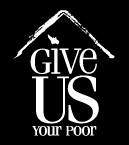I've been thinking a lot about homelessness lately as a system, particularly studying systems dynamics, an approach to understanding complex systems. There are different ways to think about a system. Writer, teacher, Donella Meadows, says a system has three components: (1) parts, (2) interconnections, and (3) a purpose.
So if we are to examine all the forces, actions, structures, and attitudes that lead to high rates of homelessness as a "system," let's look first at the purpose of such a system in the ideal. I say the ideal, because I want to think here about the system of factors acting to prevent homelessness and create/support homes for all people in the U.S.*
For starters let's describe our purpose as something like, "to end homelessness in the U.S." That's a good start. But it's negative: ending not having a home. It's more inspiring to shoot for the creation of something, something positive. How do we put our purpose in positive terms? How about: "to create decent sustainable homes for all people in the United States." By sustainable I mean that people can live there for a very long time, not necessarily that it's green (although energy efficient would be great). How about, "decent homes all people can live in for a very long time." I specifically did not mention "home ownership" or "housing" or "American citizens." I want to keep it open to how people actually live in homes because I assume there will be some rental housing, some home ownership, some communal living, some boats, whatever. If people are happy in a community, have access to food, have good social networks and are sheltered from the weather, that is my hope - the type of home I'm less concerned with. And if someone is here illegally I still don't want them living in an alleyway...for their sake or mine.
Thinking systemically about any issue--and even determining a purpose--is a team sport. Because a system involves many people it takes collaboration to define the purpose, the vision for it, and even what the system is. I whipped the above purpose out alone on a laptop for this blog. Not the best process. There are hundreds of perspectives on this system I do not, could not, have. I need to share it with people that bring different perspectives of the system. No one person can have a view of the whole system at any one time, so collaboration is vital to capture those perspectives to get us closer to the truth of how it functions (or can function). Together we'll adjust, change, add, tweak, sleep on it, share, and adjust some more. We need to talk to homeless people, low income residents, market rate renters, teachers, housing developers, legislators, service providers, not-in-my-backyard (NIMBY) folks, mainstream resource administrators, landlords, employers, public officials, health care providers/recipients, etc. I'd ask them, "What is the purpose you'd like to see for the system you're a part of that affects the creation of homes?"
We incorporate the wisdom of the group in the purpose statement. In a systemic process like this, getting the purpose statement right can take a day, a week, or longer. But it's vital and it's time well spent, like laying the foundation of a new house.
Next step (for next blog): identifying the parts of the system and their interconnections!
* My assumption here is that if we looked at the purpose of the actual system in place (as opposed to our ideal), it would not be to create homes for all people but rather to hide homelessness. Maybe it's unintended but that is the purpose of the system that's created. But, again, that's my assumption.
Photo is titled, "14 Purpose" by midoubleko and is used with permission.



No comments:
Post a Comment